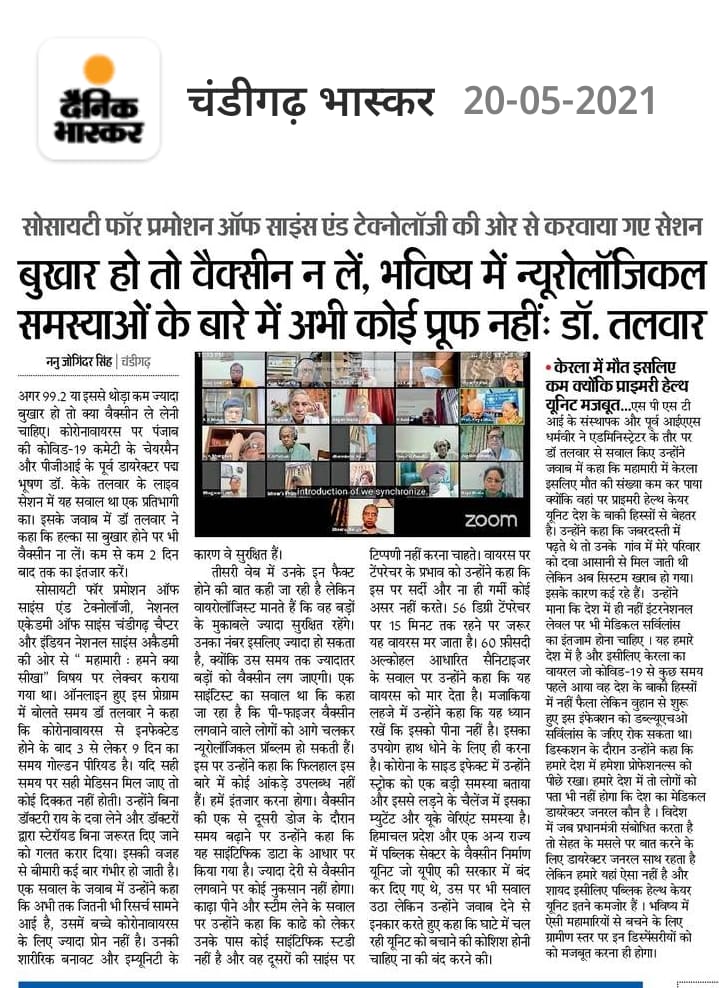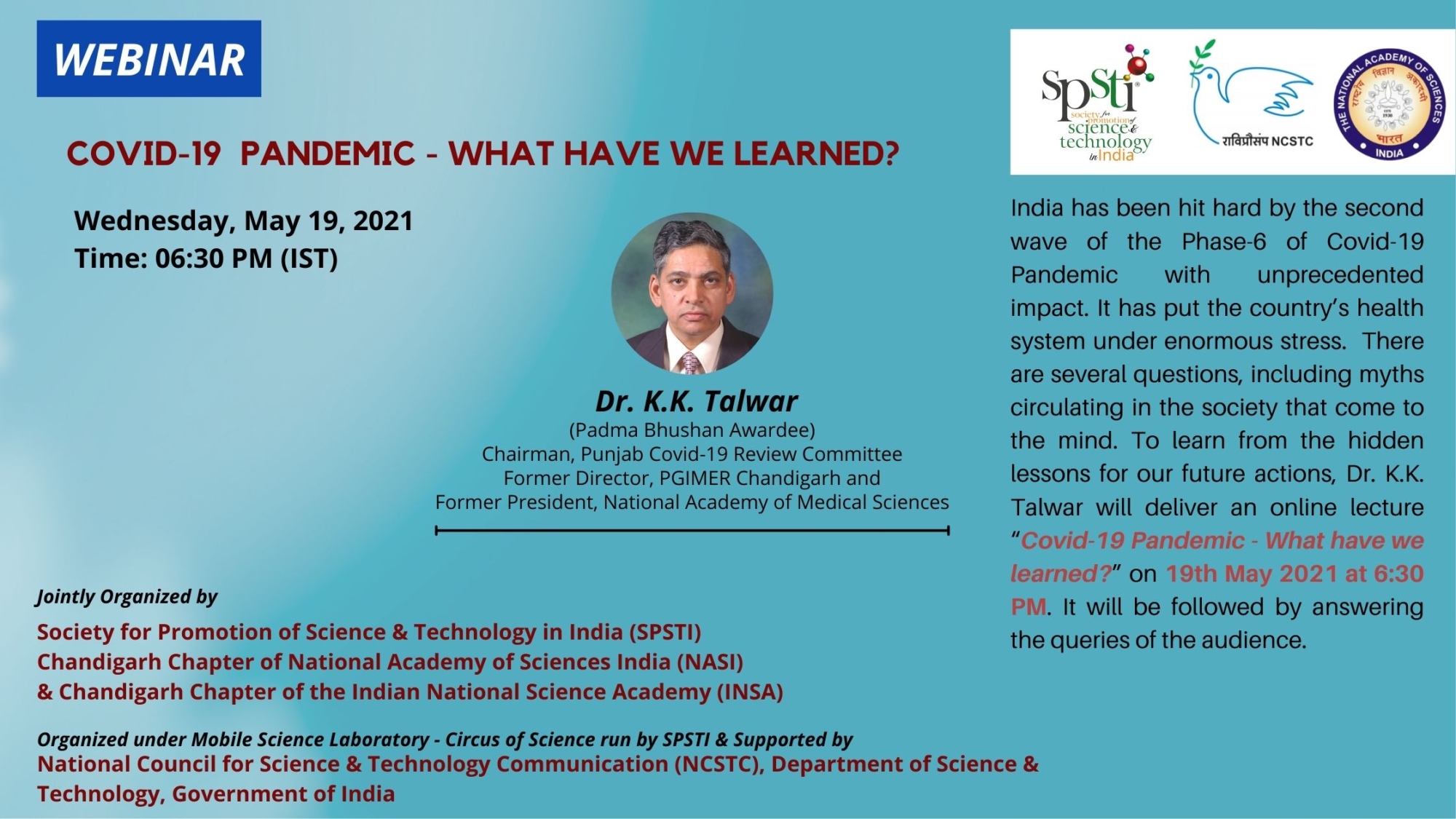The Society for Promotion of Science of Science & Technology in India (SPSTI), jointly with Chandigarh Chapter of the National Academy of Sciences India (NASI) and Chandigarh Chapter of the Indian National Science Academy (INSA) with support from National Council for Science & Technology Communication (NCSTC), Department of Science & Technology, Government of India has organized second series of lectures on “COVID-19 pandemic – What we have learned”. The first lecture of the second series was conducted on May 19, 2021 at 6.30 pm through online mode. The session was attended by more than 100 participants on the zoom and about 263 viewed the same on the Facebook page of SPSTI.
The session steered with the introduction of the series by Prof. R. K. Kohli, who welcomed the attendees and the speaker Dr. K. K. Talwar. He gave a brief overview of the activities being organized by SPSTI. The purpose and strategy of the series was explained by Prof. Arun Kumar Grover, Former Vice Chancellor of Panjab University and Vice President of SPSTI. He shared the perspective of the expository series of lectures on COVID-19. Chandigarh Chapter of INYAS arranged four lectures in the first series in the first week of February. In February the active COVID-19 cases in India dipped to around 1000 per day with commencement of vaccination for health workers on January 16 and for senior citizens to commence on March 1. But, the second wave of COVID-19 soon hit back and it is clear that the pandemic is set to stay for long and there is a need to plan strategies to address the offset of pandemic on all sections of society. This second series of lectures on “Covid-19 Pandemic – What have we learned?” will have eight expository lectures by eminent icons of India. Shri Dharam Vir, IAS (Retd.) & President SPSTI introduced the speaker Dr. K. K. Talwar, Padma Bhushan awardee, Chairman, Panjab COVID-19 Review Committee, Former Director, PGIMER Chandigarh and Former President, National Academy of Medical Sciences.
He began his lecture stating COVID-19 is a disease which is not following any rule of medicine. Talking about the historical timeline he shared, the first case was identified on December 1, 2019 in Wuhan, China. On December 21, some doctors in Wuhan observed pneumonia-like cases but causes were unknown. On Dec 30 Dr. Li Wenliang warned other doctors about a possible outbreak of an illness resembling SARS. But, he was warned by the Public Security Bureau of Wuhan and was accused of ‘spreading rumours’, and then he had to apologies and unfortunately he died after a few days as he himself developed Pneumonia. On January 8, 2020 WHO released an official statement with no recommendation of any specific measures for travellers and advice against travel/trade restrictions on China. Being onset of new year millions of people visited the city and it was on January 23, China authorities announced their first steps for a quarantine of Wuhan. He further said that the origin of the virus is still not clear, whether it was a wild origin or leak from the virology lab in Wuhan.
Talking about the mode of transmission, it is from human to human through droplet, direct contact with mucus members or infected surface and in closed places it is also due to aerosol. He also shared that droplets of size less than 5 micron can travel up to distance of 10 feet in the closed environment. To control the spread of this virus it is mandatory to use mask, maintain physical distance of at least 3 feet, observer hand hygiene and closed spaces must be properly ventilated. He shared data where the use of mask showed the decline in cases of hospitalization. As the transmission is mostly through asymptomatic individuals, wearing mask not only reduce the spread but also protects. He shared those countries that were in the habit of wearing masks due to earlier SARS virus in 2002-03 like Taiwan, Hong Kong, Singapore, South Korea, etc. reported less number of cases and deaths. He called wearing mask as the ‘social vaccine’.
He shared that after the first wave, the second wave was speculated in January for which we should be prepared. But, due to great decline in cases in January, it was assumed we have come out of it and which led to a relaxed attitude of government and public. As on May 15, 2021, the count for total cases for India was just next to the USA but the number of deaths reported in India were the highest among all countries.
India has been hit hard by the second wave due to the new mutant which spreads at a much faster rate, public callousness to follow social habits, laxity at policy level, lack of coordination between state and central level. Limitation of healthcare facilities had been among major reasons. He shared to control the immediate spread we need to have regulated lockdown with restriction on non-essential activities. Public should have an equal participation and there is a great need to improve the healthcare facilities. There is also increasing concern for the new mutants as they would behave.
Medically to handle the COVID-19 infection, which has majorly been spreading through asymptomatic individuals, as for the initial 2-3 days he does not know he is infected and is spreading it. He shared as per CDC, for initial 10 days, the virus is infectious but after that a person may still be positive but the virus starts shedding, so a person is no further infectious. Sharing disease progression and stages he said almost 80% of individuals recover from the infection but in about 15% of cases it is the hyper immune response of the individual that can damage the organs in the infected individual. Based on the severity of illness, various drugs are used at a varied infectious stage. He shared it is not only the lungs that get affected with the viral infection but there can be heart attack, stroke, abdominal symptoms, renal complications, skin complication and in children it may cause multisystem inflammatory syndrome due to cytokine storm. But, there is no specific approved treatment. Some therapies have been evaluated for treatment of COVID-19 but none have proven efficacy and safety. He shared that the drugs like Remdesivir have only shown some benefit in the viral phase but not in mortality. Only corticosteroids have been proved to be of some benefit in case of morality, they need to be used very carefully as they can cause major other complications.
Sharing mortality factors he said it is due to late arrivals to hospital. In certain cases even the oxygen falls below the 94% but they do not feel any problem called a happy hypoxia issue. Individuals with co-morbidity are at high risk of getting the disease and also mortality. People high on alcohol may also be badly affected with the infection. The high CFR rate in Gujarat, Maharashtra, Madhya Pradesh, West Bengal, Delhi, Punjab is possibly due to the high age and comorbid populations in these states. He shared there is natural protection in children as the ACE-2 are less in children as compared to adults and also there have been about only 14.2% of all cases in India below the age of 20 years but as the adult population is getting vaccinated this proportion may change. But children with comorbidities are at a much higher risk of getting the infection. He also shared that Mucormycosis, which is being wrongly termed as black fungus, is due to irrational and excessive use of steroids, particularly in people who are diabetic. Drugs and steroids may also cause bacterial infection, hepatic injury or even lung fibrosis due to prolonged use of oxygen. He suggests to get vaccinated to achieve herd immunity, which can lower the overall amount of viruses able to spread in the whole population. He briefly discusses the various vaccines available in India and around the globe. He shared data, though India is at second place among nations when looking at the number of people who have received at least one dose but when we look at the share of purple who have received at least one dose, India is still at ten to one with such a large population. He shared that the rate of reinfection is about 4.5% as per the data shared by ICMR, but the chance of getting severe issues after getting both the doses are very minimal. He also shared the various side effects due to vaccines like fatigue, muscle pain, joint paints, fever, allergic reactions, etc. He also discussed the thrombosis issues being reported with Covishield and Johson & Johnson vaccine, but these are extremely rare.
He also talked about the covariates which may decide the course of action in future. He quoted in Punjab it is the UK variant which is more prevalent. The UK variant and triple mutant may have vaccine escape potential. He says mutation are common in virus and often may not change the virus properties but the mutation is in COVID-19 is much faster than the scientist can make sense of them and these mutants are able to transmit more easily and are showing more serious symptoms in younger people.
He also talked about the Indian health system where both state and central government are busy blaming each other and abdicating from the responsibilities. He says to strengthen the health system there must be investment in public systems, charitable organizations should be supported and corporate should also be facilitated.
He summarized his talk stating that 80-85% are mild cases who recover at their own, 10-15% can be managed with supportive care and it is 3-5% who are critical and drugs can be used to reduce mortality in these case. He advocated social distance, wearing mask and sanitization must be religiously followed and vaccination should be taken at the earliest.
The session was much appreciated by the audience and followed with questions about efficacy of vaccines for new variants, time gap between two vaccination dosage, chances of reinfection, serious after effects after recovering from COVID-19 and need for medical surveillance in India to effectively deal with COVID-19. Prof. K.K. Bhasin thanked the speaker as well as the attendees.
Watch Complete Lecture
Media Coverage


